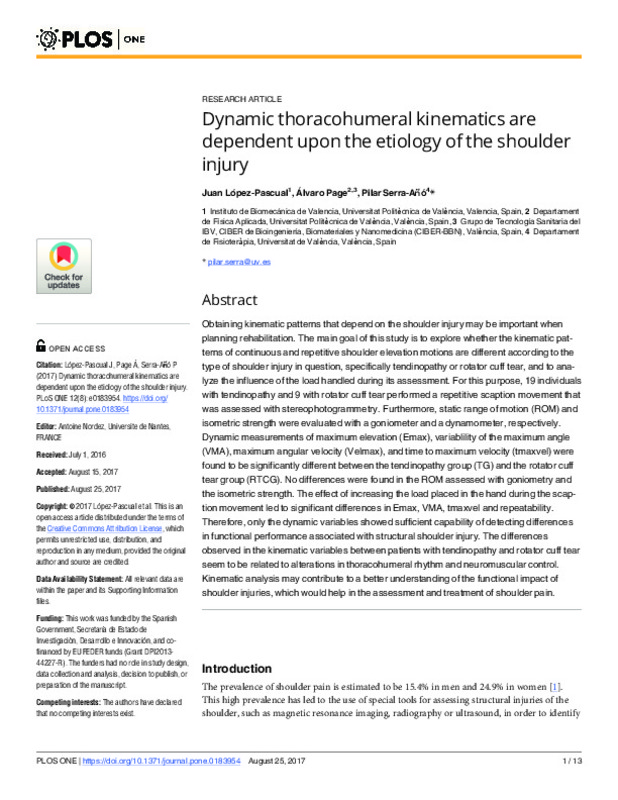JavaScript is disabled for your browser. Some features of this site may not work without it.
Buscar en RiuNet
Listar
Mi cuenta
Estadísticas
Ayuda RiuNet
Admin. UPV
Dynamic thoracohumeral kinematics are dependent upon the etiology of the shoulder injury
Mostrar el registro sencillo del ítem
Ficheros en el ítem
| dc.contributor.author | Lopez Pascual, Juan
|
es_ES |
| dc.contributor.author | Page Del Pozo, Alvaro Felipe
|
es_ES |
| dc.contributor.author | Serra Añó, Pilar
|
es_ES |
| dc.date.accessioned | 2018-06-16T04:25:14Z | |
| dc.date.available | 2018-06-16T04:25:14Z | |
| dc.date.issued | 2017 | es_ES |
| dc.identifier.issn | 1932-6203 | es_ES |
| dc.identifier.uri | http://hdl.handle.net/10251/104216 | |
| dc.description.abstract | [EN] Obtaining kinematic patterns that depend on the shoulder injury may be important when planning rehabilitation. The main goal of this study is to explore whether the kinematic patterns of continuous and repetitive shoulder elevation motions are different according to the type of shoulder injury in question, specifically tendinopathy or rotator cuff tear, and to analyze the influence of the load handled during its assessment. For this purpose, 19 individuals with tendinopathy and 9 with rotator cuff tear performed a repetitive scaption movement that was assessed with stereophotogrammetry. Furthermore, static range of motion (ROM) and isometric strength were evaluated with a goniometer and a dynamometer, respectively. Dynamic measurements of maximum elevation (Emax), variablility of the maximum angle (VMA), maximum angular velocity (Velmax), and time to maximum velocity (tmaxvel) were found to be significantly different between the tendinopathy group (TG) and the rotator cuff tear group (RTCG). No differences were found in the ROM assessed with goniometry and the isometric strength. The effect of increasing the load placed in the hand during the scaption movement led to significant differences in Emax, VMA, tmaxvel and repeatability. Therefore, only the dynamic variables showed sufficient capability of detecting differences in functional performance associated with structural shoulder injury. The differences observed in the kinematic variables between patients with tendinopathy and rotator cuff tear seem to be related to alterations in thoracohumeral rhythm and neuromuscular control. Kinematic analysis may contribute to a better understanding of the functional impact of shoulder injuries, which would help in the assessment and treatment of shoulder pain. | es_ES |
| dc.description.sponsorship | This work was funded by the Spanish Government, Secretaria de Estado de Investigacion, Desarrollo e Innovacion, and co-financed by EU FEDER funds (Grant DPI2013-44227-R). The funders had no role in study design, data collection and analysis, decision to publish, or preparation of the manuscript. | es_ES |
| dc.language | Inglés | es_ES |
| dc.publisher | Public Library of Science | es_ES |
| dc.relation.ispartof | PLoS ONE | es_ES |
| dc.rights | Reconocimiento (by) | es_ES |
| dc.subject.classification | FISICA APLICADA | es_ES |
| dc.title | Dynamic thoracohumeral kinematics are dependent upon the etiology of the shoulder injury | es_ES |
| dc.type | Artículo | es_ES |
| dc.identifier.doi | 10.1371/journal.pone.0183954 | es_ES |
| dc.relation.projectID | info:eu-repo/grantAgreement/MINECO//DPI2013-44227-R/ES/METODOLOGIA DE DISEÑO DE SISTEMAS BIOMECATRONICOS. APLICACION AL DESARROLLO DE UN ROBOT PARALELO HIBRIDO PARA DIAGNOSTICO Y REHABILITACION/ | es_ES |
| dc.rights.accessRights | Abierto | es_ES |
| dc.contributor.affiliation | Universitat Politècnica de València. Departamento de Física Aplicada - Departament de Física Aplicada | es_ES |
| dc.contributor.affiliation | Universitat Politècnica de València. Instituto Universitario Mixto de Biomecánica de Valencia - Institut Universitari Mixt de Biomecànica de València | es_ES |
| dc.description.bibliographicCitation | Lopez Pascual, J.; Page Del Pozo, AF.; Serra Añó, P. (2017). Dynamic thoracohumeral kinematics are dependent upon the etiology of the shoulder injury. PLoS ONE. 12(8). https://doi.org/10.1371/journal.pone.0183954 | es_ES |
| dc.description.accrualMethod | S | es_ES |
| dc.relation.publisherversion | http://doi.org/10.1371/journal.pone.0183954 | es_ES |
| dc.type.version | info:eu-repo/semantics/publishedVersion | es_ES |
| dc.description.volume | 12 | es_ES |
| dc.description.issue | 8 | es_ES |
| dc.identifier.pmid | 28841697 | |
| dc.identifier.pmcid | PMC5571960 | |
| dc.relation.pasarela | S\351298 | es_ES |
| dc.contributor.funder | Ministerio de Economía, Industria y Competitividad | es_ES |








